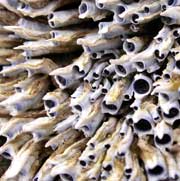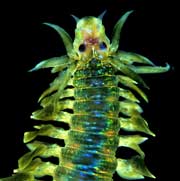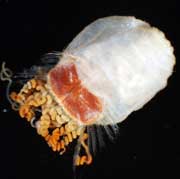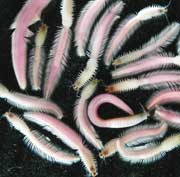
| About | | Search taxa | | Taxon tree | | Search literature | | Specimens | | Distribution | | Checklist | | Stats | | Log in |
The World Polychaeta DatabaseThis World Database of all species of Polychaeta ever described, is part of the World Register of Marine Species (WoRMS), a global initiative to provide a register of all marine organism names. IntroductionPolychaetes are multi-segmented worms living in all environments in the world's oceans, present from abyssal depths to shallow estuaries and rocky shores, and even free swimming in open water. They are strictly aquatic annelids, but are the most abundant and diverse group of Phylum Annelida. Notably successful in mud and sand habitats, their densities there often exceed those of the sediment-dwelling molluscs and crustaceans alongside them. Polychaetes have soft bodies usually at most only a few centimetres long and pencil-thick, and they move relatively slowly, aided on each segment by the retractable grip of four dense clusters of bristles and hooks called chaetae, thus the name 'polychaete'. Each of the over 80 families living today have characteristic body shapes and chaetal types. The families include for example centipede-like free-living crawlers like the nereidids and phyllodocids, colonial reef-building static forms with fans of head tentacles like the serpulids and sabellariids, flattened worms protected with shield-like dorsal scales like the polynoids, and predatory swimming worms with giant eyes like the alciopids. There are polychaetes specialised in many other unique ways, including in the ways they reproduce. Notably most Syllidae, Nereididae, and some Eunicidae (Palolo worms) metamorphose to become night-time swimmers to meet their mates, with timing of swarmings synchronised with the phases of the moon. Origin and editingThe World Polychaeta Database arose from a merger in 2007 of the massive World Register of Polychaeta compiled privately over many years by the late Kristian Fauchald (Smithsonian Institution) with the European Register of Marine Species (ERMS), and some other regional compilations including for Antarctic seas, which were already online. The database incorporates and has evolved from original cataloguing work of Olga Hartman at the Allan Hancock Foundation, published in 1951 (bibliography), 1959, and 1965 (catalogues & additional bibliographies). The taxonomy in the World Polychaeta Database is edited and updated by volunteer experts, assisted by the Database Management Team (DMT). Currently there are about 28,258 name records and 13,046 valid species (see stats). Inevitably the database includes some duplications of taxa and literature records, and there will be some polychaete names listed which are junior synonyms but not yet linked to the senior name. The editors aim to resolve all conflicting or out of date records promptly when noticed, and we hope you will tell us about any duplications or other confusions you find. Taxonomists are encouraged to send us a copy of new publications so that we can see the details of new and changed nomenclature. If you happen to disagree with any of our editing decisions, please help us by making a reasoned case for any alternative you suggest. Coverage of fossil names is likely to remain incomplete, although we would like to include all fossil genera. Polychaeta editors have taxon responsibilites as follows:
Former contributors and editors are listed here In honor of Kristian FauchaldIn honor of the late Kristian Fauchald, we celebrate 1 July 2015 as International Polychaete Day. CitationUsage of data from the World Polychaeta Database in scientific publications should be acknowledged by citing as follows:
Individual pages are individually authored and dated. These can be cited separately: the proper citation is provided at the bottom of each page. Photo credits: polynoid and sabellid images in banner courtesy of Arthur Anker (UFC), phyllodocid by Leslie Harris (LACM), sternaspid by Chris Glasby (MNT), other images by Geoff Read (NIWA). |




